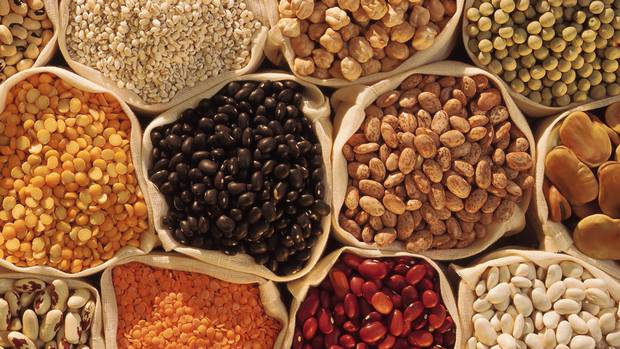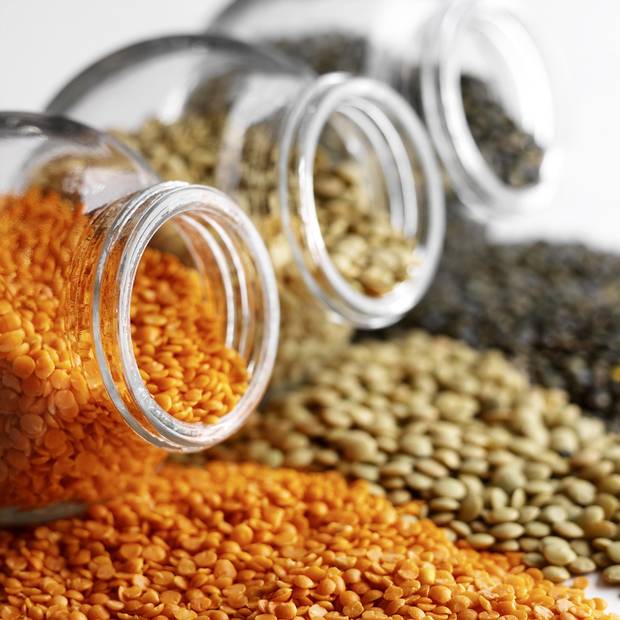
Much of the recent attention on pulses is the result of years of painstaking planning by the global pulse industry to rebrand their product
Comstock
At a glittering cocktail reception in Toronto's financial district last week, a woman peered over one of the food stations, scanning the goat-cheese canapés and braised beef short ribs on display. "I heard there were scallops here," she said. "I need something to wash down the champagne."
The glamour of the evening – with Michael Smith as its celebrity-chef host and guest list of food writers, bloggers and chefs – was in stark contrast to the event's actual purpose: to celebrate the humblest of food groups, pulses. Pulses include lentils, chickpeas, dried beans and peas. Every dish served that evening featured pulses: curried chickpea crepes, navy beans stuffed into crab cakes, and red lentil "risotto" – carefully spooned atop sea scallops.
"We're taking pulses from being this old thing, which most people associate with pea soup, to rediscovery. People are rediscovering pulses," said Lee Moats, a Saskatchewan lentil farmer and chair of Pulse Canada, the national industry association.
The Toronto cocktail reception was also just one of dozens of similar "Pulse Feasts" around the world that day. It also followed a flurry of media attention focused on the health and environmental benefits of pulses. Newspaper headlines, including a couple in The Globe and Mail, espoused the nutritional benefits, and proclaimed pulses a 2016 top food trend. Bloggers anointed pulses next in line – after quinoa, pomegranates and the acai berry – as the next big "superfood."
But all of that sudden attention was not a coincidence.
The party, and much of the recent media coverage, has been the culmination of years of painstaking planning by the global pulse industry to rebrand their product – a massive global campaign that has taken industry members from the lentil fields of Saskatchewan to meetings with federal ministers and boardrooms in Dubai and around the world. One guest at the Toronto party, a food-industry veteran for over 30 years, said he's never seen such a co-ordinated campaign to promote a product.
The staggering effort, which included successfully lobbying the United Nations to designate 2016 the International Year of the Pulses, highlights the increasingly dramatic lengths food companies are taking to capture the attention of consumers. And no wonder. Being crowned "the next thing" means big business – just ask the quinoa producers in Latin America, who saw export sales increase from $700,000 (U.S.) in 1992 to $111-million (U.S.) in 2012. Ever since the UN designated 2013 the International Year of Quinoa, Northern Quinoa Corp., one of Canada's biggest producer of the grain, has not been able to keep up with demand, and the company has just signed a lease on a facility eight times the size of their current one.
Several years ago, members of the Global Pulse Confederation, which represents over 600 industry members around the world, were concerned. Production was consistently strong, but the vast majority of pulses were being exported to developing countries – Canada alone exported $2-billion worth in 2010 – with what seemed like lagging interest in North America. The Canadians were especially mystified, given that the product is locally grown, and offers benefits that seem to present a solution to larger problems, like obesity and environmental sustainability.
It wasn't a crisis, Mr. Moats said, "but we had reached a place where it was 'Where to from here?'"

The UN’s Food and Agriculture Organization passed a resolution in 2013 to officially designate 2016 the year of the pulses. Last November, UN secretary-general Ban Ki-moon officially launched the year of pulses with a statement from Rome.
ROYALTY-FREE/GETTY
It was around that time when the then head of the Global Pulse Confederation (GPC), a Dubai-based pulse trader named Hakan Bahceci, brought an unconventional idea to the table. What if they got the United Nations involved?
"I remember my reaction was, 'That's a stretch,'" said Gordon Bacon, Pulse Canada's CEO. Still, it wasn't without precedent. Each year, the UN selects an issue to bring attention to, everything from "light and light-based technologies" (2015) to "solidarity with the Palestinian people" (2014). Some foods have been selected in the past, including quinoa, potatoes and rice.
Members of the GPC, including Mr. Bacon, began meeting with politicians, as well as officials with the UN's Food and Agriculture Organization to make their case. In those meetings, they outlined the role pulses could play in addressing larger international priorities, like hunger and food security.
It worked. The resolution passed in 2013 to officially designate 2016 the year of the pulses – a decision made years in advance in order to give organizers sufficient time to prepare. In November of last year, UN secretary-general Ban Ki-moon officially launched the year of pulses with a statement from Rome.
Alongside the UN project, the GPC also began working with Chicago-based ad agency Leo Burnett. Pulse Canada, which in recent years has received over $3.5-million from the federal government for marketing, described the rebranding campaign in a newsletter as designed to "inform and inspire a millennial generation; an audience that expects more from food."
To deliver their message, the Saskatchewan Pulse Growers hired Mr. Smith, a Food Network television host, as spokesperson. In one project, a video series called Lentil Hunters, Mr. Smith travelled around the world finding the best lentil recipes.
In an interview, Mr. Smith said he's often approached by food companies looking to hire him. He only agreed to work with the pulse group, he said, because they fit with his brand of simple, healthy cooking. "I care passionately about this stuff," he said. "Yes, there's a lot of disingenuous crap out there, and a lot of it comes flowing through my office, and we tell them to get lost, frankly."
Dana McCauley, a food trend expert and former food editor, said she's seen her share of marketing attempts by food companies. "Pretty much every June or November, I would get a press release or something that said, 'Fondue pots are back,'" she said.
The most successful attempts, she said, are the ones that play into a deeper need, or social movement. Pomegranates made sense because they fit into a bigger movement of health and wellness. She said pulses, with the campaign's emphasis on nutrition and sustainability, could be similarly successful.
And while most people believe they're making their own choices at grocery store shelves, free of the influence of others, Ms. McCauley suggested this may not always be the case.
"[Consumers] should consider the source of the information they're getting about what's new and hot, even if it comes from their favourite bloggers," she said. "I don't think people realize how much of the content they see on Instagram and Facebook and Twitter and blogs – how much of it is sponsored."
By the time the Toronto cocktail reception was winding down – and after the guests had left with their goodie bags stuffed with roasted chickpeas and lentil bark – the hashtag #LovePulses was trending on Twitter. Within hours, a Toronto blogger had already written up his assessment of the event. "I think I'm starting to dig lentils!"

What are Pulses?
Pulses are the edible seeds of plants in the legume family, which includes dried beans, dried peas, chickpeas and lentils. The term "pulse" comes from the Latin word "puls," meaning a thick soup.
Are they good for you?
Pulses have twice as much protein as other whole grains like wheat, barley or rice. Eating pulses as a replacement for animal protein helps limit the amount of saturated fats in our diets.
Pulses are high in fibre, which helps decrease and control cholesterol and blood sugar levels.
Pulses are also high in B-vitamins and key minerals including iron, potassium, magnesium and zinc.
Where are pulses grown?
Saskatchewan makes up close to 80 per cent of the total pulse area in Canada (1.7-million hectares) thanks not only to its soil and climate, but also because of its proximity to western ports for shipping to Asia. Pulses are also grown in Ontario, Manitoba and Alberta.
Pulses are good for the environment, too
Pulse production has a significantly lower carbon footprint than production of animal protein. According to the Global Pulse Confederation: Producing one kilogram of legumes = 0.5 kg in Co2 equivalent, compared with 9.5 kg in Co2 equivalent for one kilogram of beef.
Planting pulses leaves behind nitrogen in the soil, providing valuable nutrients to future crops. Growing them in rotation with other crops can also disrupt disease and insect cycles.
By the numbers
1.5 billion – 2010 farm cash receipts from pulses, which increased from $56.1-million in 1980.
35 per cent – Canada's share of the global pulse trade. An estimated 70 per cent of Canada's production is exported.
2.1 million tonnes – Amount of dry peas produced in Canada in 2011. That year, Canada produced more lentils and dry peas than any other country, 34.8 per cent of the global total of lentils (1.5-million tonnes) and 21.7 per cent of dry peas. Also in 2011, Canada's chickpea production ranked ninth globally (90,800 tonnes) and 27th overall for dry bean production (144,600 tonnes).
$2.25-billion – Total value of Canada's 2011 exports of lentils ($873-million), dry peas ($1.1-billion), chickpeas ($65.6-million) and dry beans ($207.6-million). Canadian pulses are exported mainly to Turkey (lentils and chickpeas), India and China (dry peas) and the United States (dry beans).
75 per cent – Share of global food pulses consumed in developing countries.
Sources: Pulse Canada, Statistics Canada, Food and Agriculture Organization of the United Nations